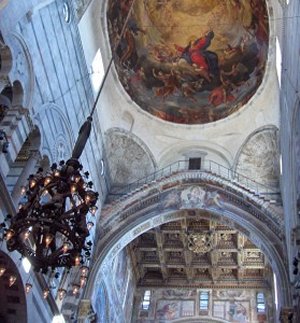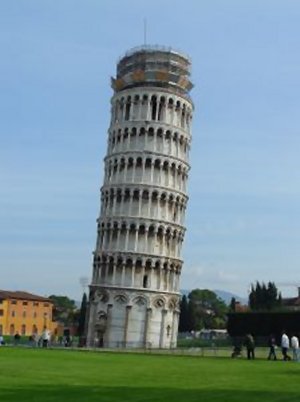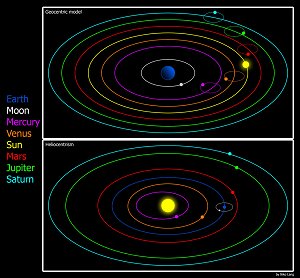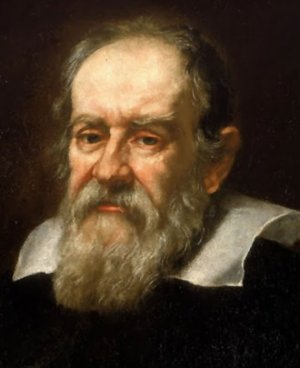While he was a student at the University of Pisa he began to study the pendulum by watching a suspended lamp swing back and forth in the cathedral. From these first observations came his theory for the pendulum clock. Near the end of his life he would design the first pendulum clock.

Galileo is called the Father of Modern Science. He was the first to develop a scientific theory in which he would observe an event, develop a theory and then experiment to test his theory.
He studied motion and performed experiments by dropping objects from heights such as the Leaning Tower of Pisa. He wanted to disprove Aristotle's idea that heavier objects fall faster than lighter ones. According to legend he dropped two objects of different weights and proved that two falling objects of different weights reach the ground at the same time. You can view a photograph of a falling objects demonstration.

In this video astronaut David Scott demonstrates Galileo's theory of falling objects by showing how they behave in a weightless environment.
Before Galileo's time many people believed the earth was the center of the universe and the sun and the planets moved in an orbit around the earth. This theory was described by a Roman astronomer named Ptolemy (TAH luh me) and was called the Ptolemaic (tah luh MA ik) Theory. Aristotle also believed the sun moved around the earth. To believe otherwise was considered heresy by the Roman Catholic Church, and people were persecuted who believed the earth was not central.
Nicolaus Copernicus (nik uh LA us ko PUR nih kus) about twenty years before Galileo was born published a theory that the earth revolved around the sun. It was called the Copernican (ko PER nih kuhn) Theory, but he died before he could prove it.
Galileo decided he would either prove Copernicus' theory or else show it was false. In 1609 he heard about an invention which enabled people to see things far away. It was the telescope. He reproduced it and studied the moon and the planets. He discovered four bright "stars" revolving around Jupiter and concluded they must be planets near Jupiter. He called them Medician (med uh CHEE un) Stars to honor his patron in the influential Medici (MED ih chee) family. These moons of Jupiter are now named Io, Europa, Ganymede, and Callisto. Shortly after his discovery he was appointed Chief Mathematician of the University of Pisa. He would hold the title for life.
Galileo concluded that if "planets", as he called them, could revolve around another planet, then the planets could also revolve around another body such as the sun. His view of the cosmos* is known as heliocentrism.* This model is shown at the bottom of the illustration with the sun in the center. The upper part of the illustration shows a geocentric* model with the earth at the center.

Galileo went to Rome and appeared before the Roman Church to defend his views, but the Church considered them heresy* since his ideas were contrary to the Ptolemaic view that the sun revolved around the earth, which they considered the Biblical view. He was forbidden to discuss or write about his theory.
When a new pope was appointed Galileo had new hope that he would be heard. In April 1624 he traveled to Rome and had six audiences with Pope Urban VIII. As a result of his visit he was permitted to discuss his theory as long as he treated it as a mathematical hypothesis.*
However, after the printing of Galileo's book Dialogue* he was summoned to appear before the Inquisition.* Galileo replied that he was too ill to go to Rome. He was told he would be arrested and brought in chains if he did not come. He went to Rome where he was questioned for 18 days.
At an Inquisition the accused person had to testify, but could not ask questions nor be represented by counsel. Sometimes a person was tortured to get them to "confess", and the sentence could not be appealed.
They condemned him for heresy and put him under house arrest. He was released for a while, but there would be further hearings and he would remain under arrest the remainder of his life. Five years after his sentencing he became totally blind. He asked to be released from his imprisonment, but his plea was denied.
During his lifetime Galileo had three children; two girls and a boy. His girls were Virginia and Livia who were both raised in convents and his son, Vencenzio, was named after his grandfather, Galileo's father.
Galileo respected people. He is quoted as saying "he never met a man so ignorant but that something might be learnt from him." He did not have unkind words even for those with whom he totally disagreed.
Galileo died on January 8, 1642 while still under house arrest at his home in Arcetri near Florence.
This biography by Patsy Stevens, a retired teacher, was written in 2008.
All excerpts from The Private Life of Galileo


 A frequent question:
A frequent question: